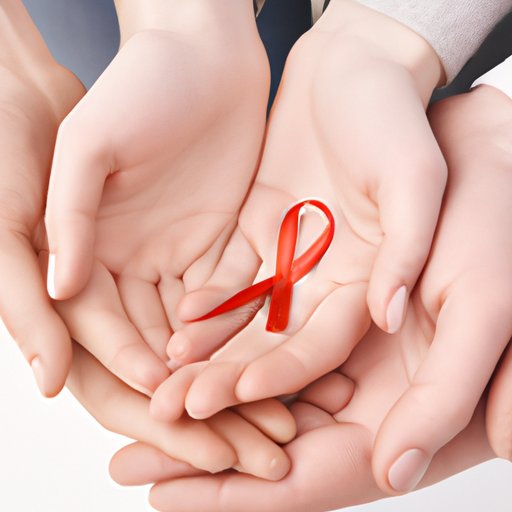
I. Introduction
Acquired Immune Deficiency Syndrome (AIDS) is a serious condition caused by the Human Immunodeficiency Virus (HIV). Despite advancements in medical treatments, AIDS remains a significant global health issue. Early recognition and treatment of HIV are crucial in preventing the progression of the virus to AIDS. The purpose of this article is to provide readers with information on how to recognize the early symptoms of AIDS, understand the causes and risk factors, take the HIV test, explore treatment options, prevent the spread of HIV, find support and resources, and understand the stigma surrounding AIDS.
II. Recognizing the Early Symptoms of AIDS
The early symptoms of AIDS can be easily mistaken for other illnesses. These symptoms include fever, fatigue, night sweats, swollen glands, and muscle aches. It is important to pay attention to these symptoms and seek medical attention as soon as possible. Other symptoms may include weight loss, oral thrush, and unusual skin rashes. However, some people infected with HIV may not show symptoms for years.
III. Understanding the Causes and Risk Factors of AIDS
The main cause of AIDS is the HIV virus. HIV is transmitted through bodily fluids, such as blood, semen, vaginal fluids, and breast milk. The most common ways of contracting HIV are through unprotected sex with an infected person or sharing needles. HIV can also be transmitted from a mother to her baby during pregnancy, childbirth, or breastfeeding.
Several factors can increase a person’s chances of contracting HIV. These include having multiple sexual partners, having a sexually transmitted infection, sharing needles, and having a weakened immune system. It is important to note that not everyone who has HIV develops AIDS.
IV. Taking the HIV Test
The HIV test is a simple blood test that detects the presence of HIV antibodies in your bloodstream. You can get tested at your doctor’s office, a medical clinic, or a community health center. Some organizations offer free and confidential testing. It is recommended that you get tested at least once, and more often if you engage in risky behaviors or believe you may have been exposed to HIV.
Getting tested for HIV can be scary and overwhelming, and it is common to have fears or misconceptions about the process. However, it is important to remember that getting tested is the first step in managing your health and preventing the spread of HIV. There are resources available to help you cope with the emotional impact of a positive diagnosis and make informed decisions about treatment options.
V. Treatment Options for AIDS
AIDS is a serious condition that requires medical care and treatment. There are several types of treatments available for people with AIDS, including antiretroviral therapy (ART) and other medications. ART is a combination of medications that slows the progression of the virus and helps to keep the immune system healthy. Other medications may be used to treat specific symptoms or infections.
It is important to work closely with your healthcare provider to monitor your condition and manage your treatment plan. Regular check-ups, blood tests, and medication adjustments are necessary to keep the virus under control and prevent the progression to AIDS. It is also important to address any concerns or questions you may have about treatment, such as side effects and costs.
VI. Preventing the Spread of HIV
Preventing the spread of HIV is essential in reducing the number of new infections. HIV can be transmitted through unprotected sex, sharing needles, and mother-to-child transmission. It is important to practice safe sex by using condoms and other barrier methods, get tested regularly, and avoid sharing needles or other injection equipment.
There are several ways to reduce your risk of contracting HIV, such as using pre-exposure prophylaxis (PrEP) medication, which can lower the risk of transmission by up to 99%. It is also important to talk openly and honestly with your sexual partners about your HIV status and to encourage them to get tested regularly.
VII. Finding Support and Resources for People with AIDS
Receiving a diagnosis of HIV or AIDS can be overwhelming and isolating. However, there are many local and national organizations that offer support, resources, and advocacy for people with AIDS. These organizations can provide information on treatment options, financial assistance, and legal rights. Support groups can also be an effective way to connect with others who have similar experiences and share coping strategies.
VIII. Understanding the Stigma around AIDS
Living with AIDS can be challenging due to the social stigma and discrimination often faced by people with the condition. It is important to reduce stigma and promote acceptance and understanding. This can be done by educating yourself and others about AIDS, speaking openly about the condition, and advocating for the rights of people with HIV and AIDS.
If you or someone you know is living with HIV or AIDS and experiencing discrimination, there are resources available to help. Your healthcare provider or local AIDS organization can provide you with information and support.
IX. Conclusion
Recognizing the early symptoms of AIDS, getting tested regularly, exploring treatment options, preventing the spread of HIV, finding support and resources, and understanding the stigma surrounding AIDS are all important in managing the virus and living a healthy life. It is important to prioritize your health and advocate for yourself and others in the fight against AIDS.





